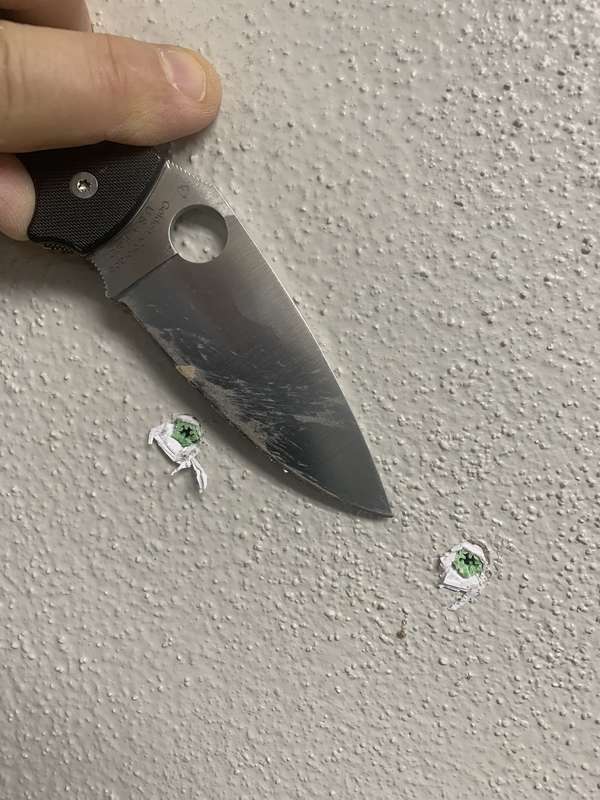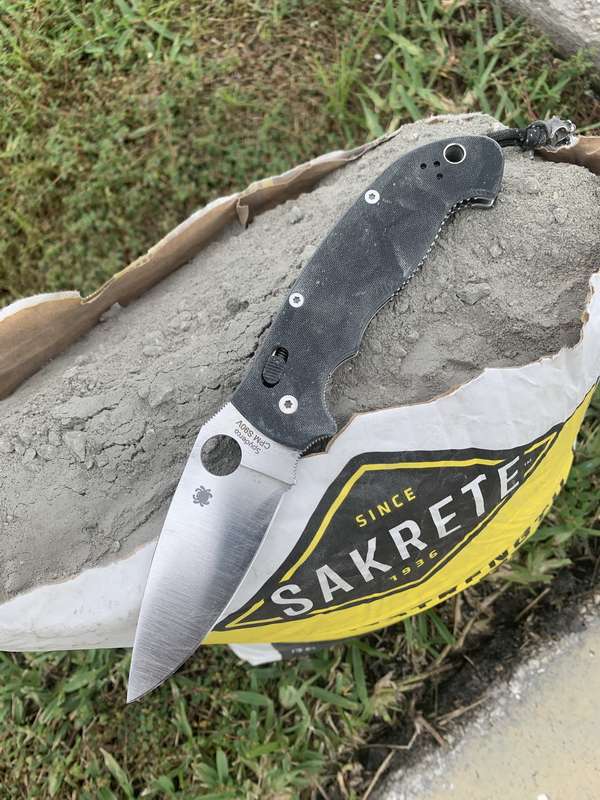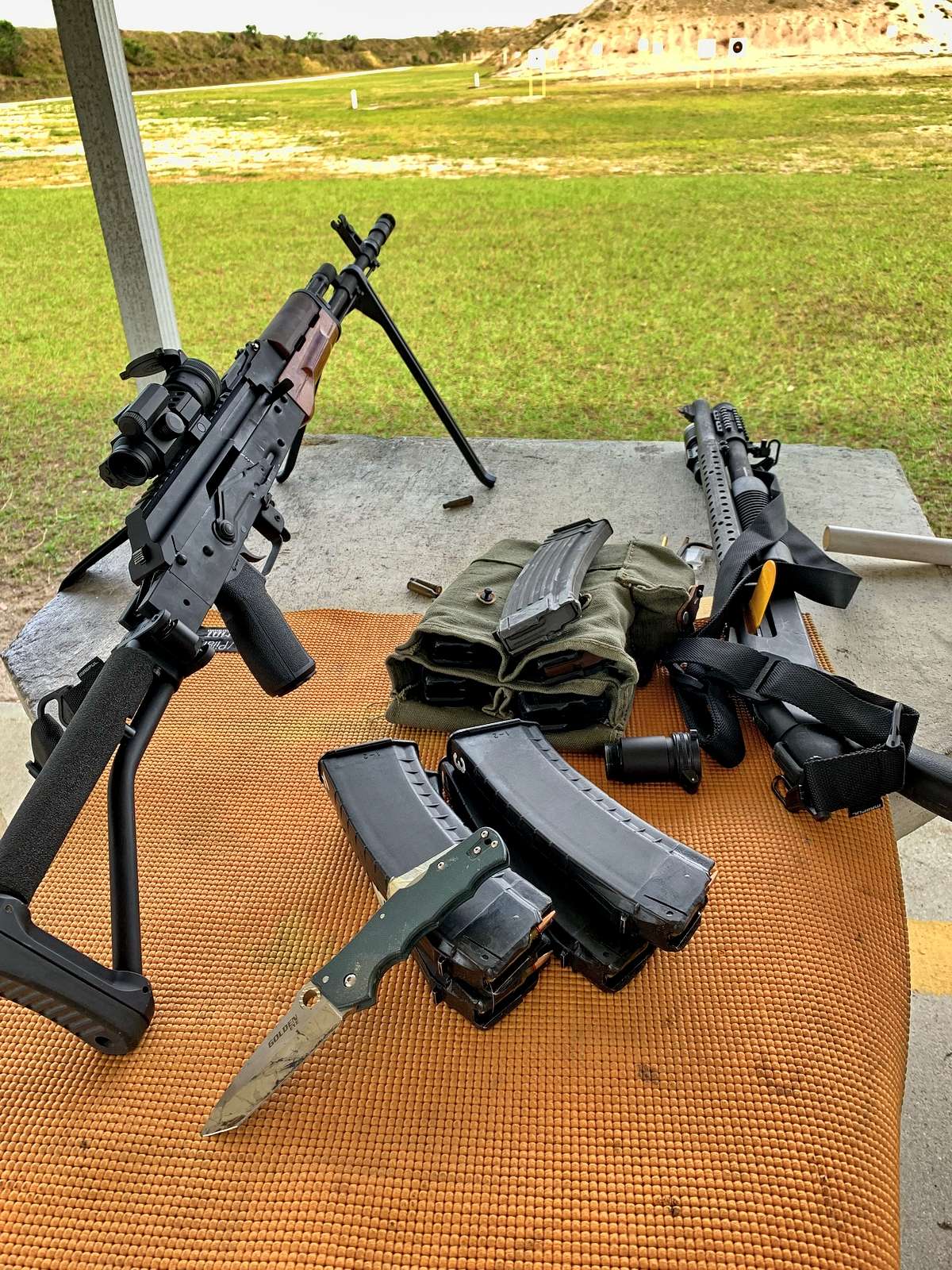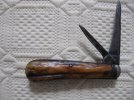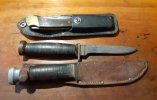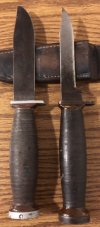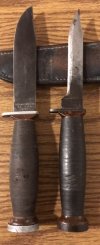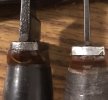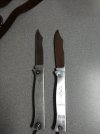-
The BladeForums.com 2024 Traditional Knife is ready to order! See this thread for details: https://www.bladeforums.com/threads/bladeforums-2024-traditional-knife.2003187/
Price is$300$250 ea (shipped within CONUS). If you live outside the US, I will contact you after your order for extra shipping charges.
Order here: https://www.bladeforums.com/help/2024-traditional/ - Order as many as you like, we have plenty.
You are using an out of date browser. It may not display this or other websites correctly.
You should upgrade or use an alternative browser.
You should upgrade or use an alternative browser.
Knives truly at the end of their careers?
- Thread starter Hashishiin
- Start date
Rufus1949
Gold Member
- Joined
- Aug 22, 2021
- Messages
- 18,166
I'm trying to wear this Winchester out ...30+ yearsView attachment 1839452
Last edited:
eveled
Basic Member
- Joined
- Mar 11, 2016
- Messages
- 8,124
The 2 in the first picture I wore down myself. It took about 25 years. Using them and keeping them sharp. (I sharpen differently now to minimize the belly loss they show).This is absolutely awesome!eveled , those Bucks are the most worn down I have ever seen, nice! Are they that size because they snapped off and were re-ground by Buck, or were they worn down to that extent?
The larger group were all bought cheap, already in that condition. I have no idea how they got so bad.
The amazing thing is as bad as those 7 Bucks are worn, only one had a worn out lock. Even more amazing is how good they look now. Buck does an amazing job.
before
After
Last edited:
My grandpa bought this knife for $1.50 at a hunting show when he was a teen in about 1944 and then cut stuff with it for 75 years. He gave it to me recently along with some other of his gear. I posted a more complete thread on all the items if you’re interested but here is a quick pick for this thread. It’s not dead yet though. Still slices up paper!


Railsplitter
Gold Member
- Joined
- Oct 31, 2010
- Messages
- 8,108
JWright214
Gold Member
- Joined
- Sep 1, 2009
- Messages
- 1,003
Not to derail the thread, I love well used knife pictures, but I’m curious about this. I’m not a freehand sharpener but I am slowly trying to teach myself with some stones and old knives as well as stropping. For my knives still in use, I use a Sharpmaker for touch ups/general maintenance, and I use a Wicked Edge for re-profiling. This combination works great for me, but I know it eats away at the blade more than freehand sharpening would, plus I’m a traditionalist at heart and I just want to learn.(I sharpen differently now to minimize the belly loss they show).
eveled
Basic Member
- Joined
- Mar 11, 2016
- Messages
- 8,124
I realized by pulling the blade off the stone in a slicing motion, rolling around the belly to the tip(as I was taught), has problems. The edge near the Ricasso is only in contact with the stone very briefly so it gets minimal wear. The belly is in contact the longest and has a smaller contact patch so it gets worn the most.
Now I sharpen the entire straight section evenly keeping the whole edge in contact with the stone for the whole stroke if possible. Like I was sharpening a wharncliff or sheepsfoot.
Then I sharpen tip to belly separately (if they even need it), like you would a chisel. Think about how you'd sharpen a tanto. Except roll around to get the belly.
This picture shows it pretty well
And I try to avoid this: with the tiniest of sharpening choils, ideally no deeper the the edge bevel
And I hate recurves View attachment 1840030
To fix a recurve I focus on the Ricasso side, and minimize loss at the belly.
I’m no wordsmith so I hope that makes sense.
Last edited:
Tetsujin 140.6
Gold Member
- Joined
- Jan 4, 2011
- Messages
- 1,212
My Grandfather's knife has been around the block a time or two.


JWright214
Gold Member
- Joined
- Sep 1, 2009
- Messages
- 1,003
Absolutely, makes total sense! It’s basically the same thing I figured out using the Wicked Edge, but for a different reason. I hate how the cutting bevel would look wider (or higher up, I’m not wordsmith either) on the tip and belly and smaller/more narrow on the straight blade. So I started sharpening the straight blade first, then work on the belly to tip portion, lastly a couple strokes of the full blade altogether. I found it makes for a much more even cutting bevel aesthetically and functionally. It also saves a lot of steel, less grinding away, and keeps the blade shape closer to the original. Here’s an example of what I mean, the old way on the Becker and the new way on the ESEE.JWright214 it began bothering me (with those 2 knives I wore out). That the blade is almost the original size just infront of the Ricasso then tapers off, with the most blade loss at the belly.
I realized by pulling the blade off the stone in a slicing motion, rolling around the belly to the tip(as I was taught), has problems. The edge near the Ricasso is only in contact with the stone very briefly so it gets minimal wear. The belly is in contact the longest and has a smaller contact patch so it gets worn the most.
Now I sharpen the entire straight section evenly keeping the whole edge in contact with the stone for the whole stroke if possible. Like I was sharpening a wharncliff or sheepsfoot.
Then I sharpen tip to belly separately (if they even need it), like you would a chisel. Think about how you'd sharpen a tanto. Except roll around to get the belly.
This picture shows it pretty wellView attachment 1840031
And I try to avoid this: with the tiniest of sharpening choils, ideally no deeper the the edge bevelView attachment 1840029
View attachment 1840046
And I hate recurves View attachment 1840030
To fix a recurve I focus on the Ricasso side, and minimize loss at the belly.
I’m no wordsmith so I hope that makes sense.


The tip and belly of the Becker looks wider and the Izula has a much more uniform bevel throughout. Hopefully that makes sense.
eveled
Basic Member
- Joined
- Mar 11, 2016
- Messages
- 8,124
Last edited:
eveled
Basic Member
- Joined
- Mar 11, 2016
- Messages
- 8,124
This is my first fixed blade. I got it from my father with the handle missing. He got it from his uncle in the 50’s. I used to use it as a throwing knife. The tang would stick in as often as the point did. It put up with a lot of abuse. So I retired if from throwing and put a series of handles on it. Finally settled on leather washers.
On Ebay I found one in original condition. I never realized it had so much blade loss
Last edited:
I have to say, I see a big difference between a knife that got used so much that it actually got "worn out", and a knife that simply suffered from bad sharpening.
It only takes a few seconds on an electric knife sharpener or grinder to take decades worth of steel off a blade. I have no doubt that many a blade suffered a premature "retirement" due to such "sharpening" methods.
It only takes a few seconds on an electric knife sharpener or grinder to take decades worth of steel off a blade. I have no doubt that many a blade suffered a premature "retirement" due to such "sharpening" methods.
- Joined
- Aug 28, 2021
- Messages
- 3,343
This poor benchmade has seen 20+ years of hard use.
Not always easy to tell the difference. Only the man doing the sharpening knows the truth.
Or the poor unfortunate owner who trusted a hack (or well-meaning friend/family member) to sharpen their knife.
In my time here I've read a few accounts from people who handed over their precious knives to "professional" knife sharpeners (like in a hardware store or shopping mall), and the knives they received back were noticeably thinner because the "professional" simply ran the blade through an electric grinder. Clearly not all "professional knife sharpeners" are knife people who care about the condition or longevity of a knife. For some, a knife is just a tool like any other, and as long as it's sharp, that's all that matters, regardless of condition (and I'm sure a lot of fathers and grandfathers felt/feel the same).
And then there are simply employees who get paid by the hour and really couldn't care less about the customers knives they are "sharpening".
A good reason for a people to learn how to do their own sharpening. Entrusting ones blade to a stranger can be the road to heartache.
- Joined
- Mar 19, 2018
- Messages
- 4,378
- Joined
- Nov 21, 2013
- Messages
- 3,416
I don’t have much new pictures of my working knives, most of it I’ve posted already but here few good-ones

